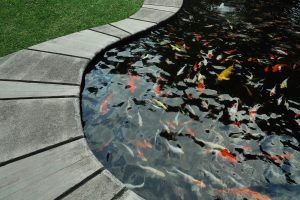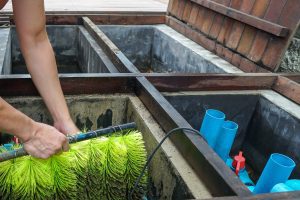
How Do Pressurised Pond Filters Work: A Clear Guide
Pressurised pond filters work by forcing water through filter media in a sealed canister to remove debris and pollutants. This process raises the question: how do pressurised pond filters work? Understanding tHow Do Pressurised Pond Filters Work: A Clear Guidehis keeps pond water clean and healthy. In this article, we’ll explore their components, process, and advantages.
Key Takeaways
Pressurised pond filters provide both mechanical and biological filtration, ensuring optimal water quality and supporting healthy aquatic ecosystems.
Key components, including diverse filter media and integrated UV clarifiers, enhance the filtration efficiency and clarity of pond water while controlling harmful microorganisms.
Routine maintenance is essential for pressurised pond filters to function effectively, including regular cleaning of filter media and monitoring for common issues like clogged filters and algae buildup.
What Is a Pressurised Pond Filter?

A pressurised pond filter is a sophisticated system that offers both mechanical and biological filtration, crucial for keeping pond water healthy. These filters are typically enclosed in sealed canisters that force water through various filter media, effectively removing debris and ensuring continuous water circulation.
One of the most appealing aspects of pressurised pond filters is their versatility. After the water is filtered, it can be directed back into the pond or used to power waterfalls and other water features, adding both functionality and beauty to your garden pond. These filters operate under pressure, which significantly enhances water flow and filtration efficiency compared to other types of filters, such as gravity filters.
Whether you place them above or below the water level, pressurised pond filters offer flexibility in pond design. This adaptability makes them an excellent choice for various pond sizes and types, ensuring that your pond remains a healthy and vibrant part of your outdoor space.
Key Components of Pressurised Pond Filters

Knowing the key components of pressurised pond filters helps appreciate their effectiveness. These filters maintain clean and healthy pond ecosystems through a mix of mechanical and biological filtration methods.
A variety of filter media lies at the core of every pressurised pond filter. These media capture debris and pollutants from the pond’s water, keeping it clear and clean. The filter media can include sponges, brushes, and other materials that trap particles as water passes through.
UV clarifiers are another vital component often found in pressurised pond filters. Built-in UV clarifiers help reduce harmful microorganisms in the water before it re-enters the pond, further enhancing water quality and clarity. This step is crucial for controlling algae and pathogens, promoting a thriving aquatic ecosystem.
The Filtration Process Explained
The filtration process in pressurised pond filters ensures optimal pond filtration and water clarity. The process starts with water being pumped from the pond into the filter, where pressure enhances filtration efficiency.
Once inside the filter, the water flows through various filter media stages. Each stage traps different types of debris and organic waste, ensuring thorough water purification. This multi-stage approach guarantees that even the smallest particles are captured, leaving your pond water crystal clear.
Besides mechanical and biological filtration, many pressurised pond filters include UV light treatment. This final stage eradicates pathogens and algae, ensuring the filtered water that re-enters your pond is not only clear but also healthy for your pond’s inhabitants.
Continuous water circulation through the filter maintains high oxygen levels, supporting a balanced and thriving aquatic plants ecosystem.
Mechanical Filtration in Pressurised Filters
Mechanical filtration serves as the first line of defense in keeping a pond clean and healthy. This involves removing physical waste and debris, preventing the build-up of leaves, fish waste, and other contaminants.
Thanks to their design, pressurised pond filters excel at mechanical filtration, trapping even the tiniest particles. Common mechanical filter media like sponges, brushes, and vortexes effectively capture debris as water passes through. This not only improves water clarity but also reduces the burden on the biological filtration stages. Additionally, a pressure filter can enhance this process.
Their pressurised design ensures efficient removal of debris and waste, keeping pond water clean and clear. By maintaining a high level of mechanical filtration, pressurised filters help create an environment where aquatic life can thrive.
Biological Filtration in Pressurised Filters
Biological filtration plays a crucial role in maintaining a healthy pond ecosystem. Beneficial bacteria break down toxic waste materials in this process, significantly improving water quality and supporting aquatic life.
In a pressurised pond filter, beneficial bacteria colonize the filter media, acting like a miniature sewage treatment system. These bacteria break down toxins like ammonia and nitrates, produced by fish and decaying organic matter. This reduces harmful waste, ensuring a healthier pond environment.
By fostering beneficial bacteria growth, pressurised pond filters support a balanced aquatic ecosystem. This balance is vital for preventing issues like algae blooms and maintaining the overall health of your pond’s inhabitants.
Advantages of Using Pressurised Pond Filters
Pressurised pond filters offer numerous advantages, making them popular among pond enthusiasts. Their primary benefit is maintaining clear and healthy pond water by effectively removing debris and pollutants through mechanical and biological filtration.
Many pressurised pond filters include integrated UV clarifiers to combat algae growth and improve overall water quality. This is beneficial for ponds prone to algae blooms, ensuring clear and aesthetically pleasing water.
Pressurised pond filters are also designed to be energy-efficient, minimizing power consumption while maximizing filtration effectiveness. This makes them a cost-effective solution for maintaining larger ponds, especially those with heavy fish stocks like goldfish and koi.
Choosing the Right Pressurised Pond Filter

Choosing the right pressurised pond filter ensures optimal filtration and healthy pond water. Consider the size of your pond and the number of fish it contains when choosing a filter.
For larger ponds or those with high fish stock, a larger filter is advisable to handle increased waste more effectively. Also, consider the available space for installation, as some filters have specific placement requirements. Many pressurised filters offer installation flexibility, whether above ground or buried, depending on your preferences.
Look for filters that include UV bulbs for enhanced water clarity and additional outlets for waste flushing, which can be directed to a drain or used in your garden. These features make for a more efficient and user-friendly filtration system.
Installation Tips for Pressurised Pond Filters
Installing a pressurised pond filter is straightforward, but following the manufacturer’s instructions closely ensures optimal performance. Proper placement and connection to the pond’s water circulation system are vital for the best results.
When installing the filter, consider using a splitter valve to adjust the pond pump output. This helps manage water flow between the filter and general pond circulation, ensuring adequate filtration and circulation.
Correct installation of your pressurised pond filter significantly improves your pond’s water health and clarity, creating a thriving aquatic environment.
Maintaining Your Pressurised Pond Filter

Routine maintenance ensures the longevity and effectiveness of your pressurised pond filter. Regular cleaning of the filter media and monitoring performance are critical for pond maintenance and a healthy pond.
Clean biological filter media with pond water to avoid harming beneficial bacteria crucial for breaking down toxic waste. Rinse mechanical filter media until the water runs clear to ensure it continues capturing debris effectively.
Proper care and maintenance can extend the lifespan of pressurised pond filters for many years, providing a long-term solution for clean and healthy pond water. Built-in cleaning mechanisms in many filters simplify routine maintenance.
Common Issues and Troubleshooting
Like any filtration system, pressurised pond filters can encounter common issues that affect performance. Common problems include clogged filter media, insufficient water flow, and algae buildup.
To address these issues, thoroughly clean the filter media, check for blockages, and use UV clarifiers to control algae growth. Regular maintenance, including routine cleaning and timely checks for wear and tear, prevents future filter problems.
By staying vigilant and addressing issues promptly, you ensure your pressurised pond filter operates effectively, maintaining a healthy and beautiful pond.
Summary
Understanding how pressurised pond filters work and their benefits can transform your pond into a thriving, healthy ecosystem. These filters provide efficient mechanical and biological filtration, ensuring clear and healthy water for your pond’s inhabitants.
By choosing the right filter, installing it correctly, and maintaining it regularly, you can enjoy the beauty and serenity of a well-maintained pond. Embrace the knowledge shared in this guide to keep your pond clean and vibrant for years to come.
Frequently Asked Questions
What is a pressurised pond filter?
A pressurised pond filter is an efficient filtration system that utilizes both mechanical and biological processes to purify pond water, promoting a healthy aquatic environment. It is essential for maintaining water clarity and quality.
How do I choose the right pressurised pond filter?
To choose the right pressurised pond filter, assess the pond’s size, fish population, and installation space. Selecting a larger filter with features such as UV bulbs and waste flushing outlets will enhance its effectiveness.
What are the benefits of using a pressurised pond filter?
Using a pressurised pond filter significantly improves water clarity and reduces algae growth, making it an efficient choice for ponds, especially those with high fish populations. These filters are versatile and energy-efficient, ensuring optimal pond health.
How often should I maintain my pressurised pond filter?
It is essential to maintain your pressurized pond filter regularly, cleaning the biological media with pond water and rinsing the mechanical media until clear. Regular checks on performance are also recommended to ensure optimal function.
What are common issues with pressurised pond filters and how can I troubleshoot them?
Common issues with pressurized pond filters include clogged filter media, insufficient water flow, and algae buildup. To troubleshoot, ensure thorough cleaning, check for any blockages, and consider using UV clarifiers to manage algae growth effectively.



